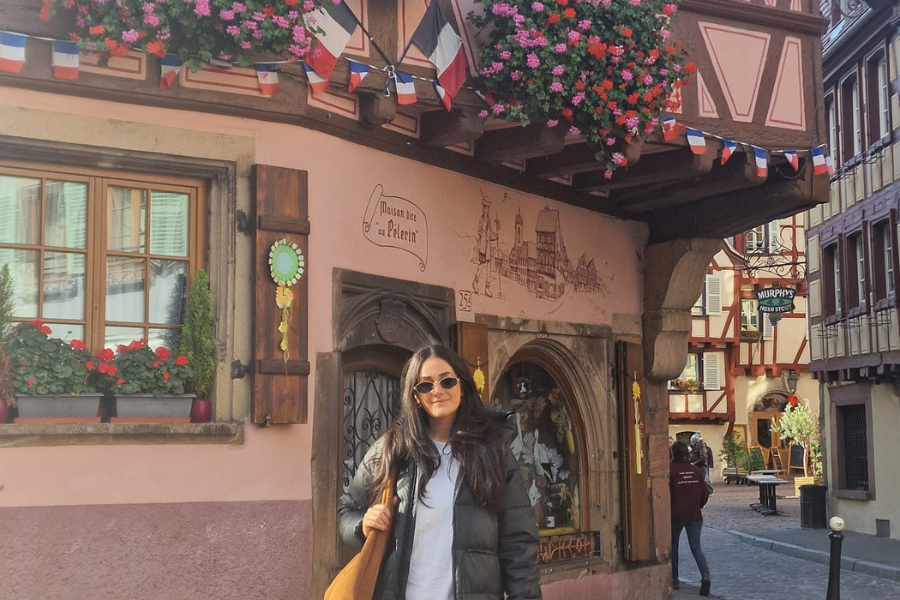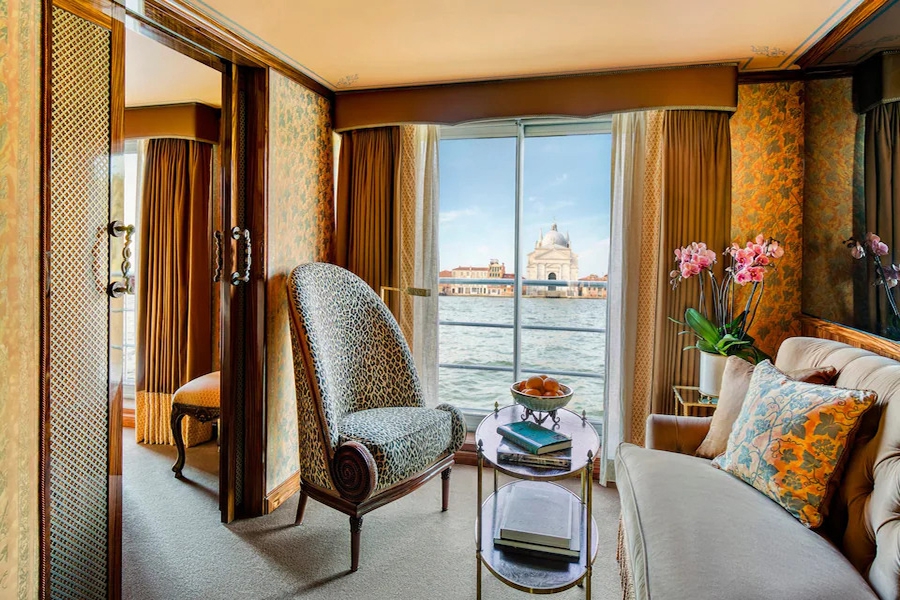
A fashionista floats Gary Buchanan's boat in Venice
Throughout the world, there are ports that assume a special place in the atlas of the imagination: the iconic landmarks of Sydney; the concrete and glass backdrop of New York; the neon-clad, frenetic mêlée that is Hong Kong. All exude magic, especially when viewed from the deck of a cruise ship, but there’s one city where every vista, every illusion, and every emotion is doubled because it's mirrored in the water, and that's Venice.
Known as La Serenissima – the most serene, Venice did for artistry what Greece did for democracy. With its surfeit of beauty, the implausible setting - interspersed with colonnades and pinnacles, campanile and domes - is not so much faked as well edited, costumed, and choreographed.
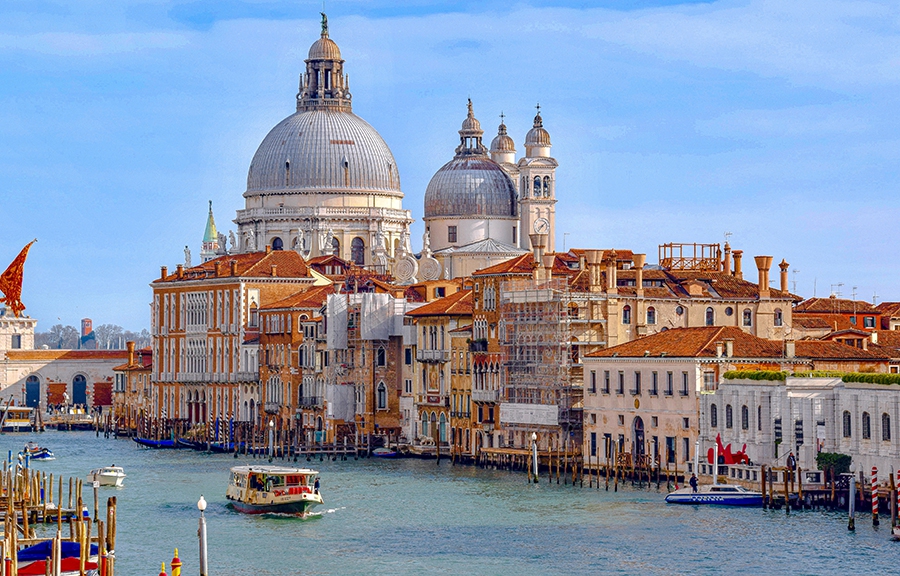
“STREETS FULL OF WATER – PLEASE ADVISE.” So ran the telegram sent back to New York by the American humorist Robert Benchley, when he arrived in Venice for the first time. Of course he had a point; the fact that Venice uses water in much the same way that other cities use tarmac is just one inimitable characteristic of this city that exceeds every expectation.
Offering a unique contribution to civilised city life, Venice has influenced Western civilisation more than any other city in terms of painting, architecture, music, and sculpture. Impressive qualities, undoubtedly, but not so remarkable when you consider that it was the longest-lived republic the world has ever known. For almost a thousand years, this city at the northern tip of the Adriatic was the acknowledged mistress of the Mediterranean – the richest, most powerful, and by far the most opulent state Europe has ever seen.
Never once throughout the city’s colourful history was it invaded or destroyed. The two and a half miles of shallow lagoon that separate this timeless, sophisticated city from the mainland not only acted as protection from civil wars, it was instrumental in the establishment of a monumental trading empire – the envy of the civilised world.
At the heart of the city, Piazza San Marco is a dazzling medley of European and Byzantine architecture. Founded in the 9th century, the Basilica San Marco, crowned by the colourful ‘Last Judgement’ mosaic, dominates this timeless square in a magnificent blast of papal pomp, rearing above the tourists like a cardinal among curates.
No matter where you meander, the Rialto Bridge never seems far away. Built in 1592, two rows of shops give this bridge its distinctive appearance. The broad, inverted S-shaped waterway that is the Grand Canal divides the city into two halves. Fronting either side are the facades of timeless palazzi such as the Ca’ d’Oro, Palazzo Grassi, and Palazzo Dario, little changed since Canaletto and Tiepolo used their brushstrokes to such evocative effect. This main artery of the city remains a hub of activity, with vaporettos, speeding taxis, decorous gondolas, and supply boats weaving in between each other.
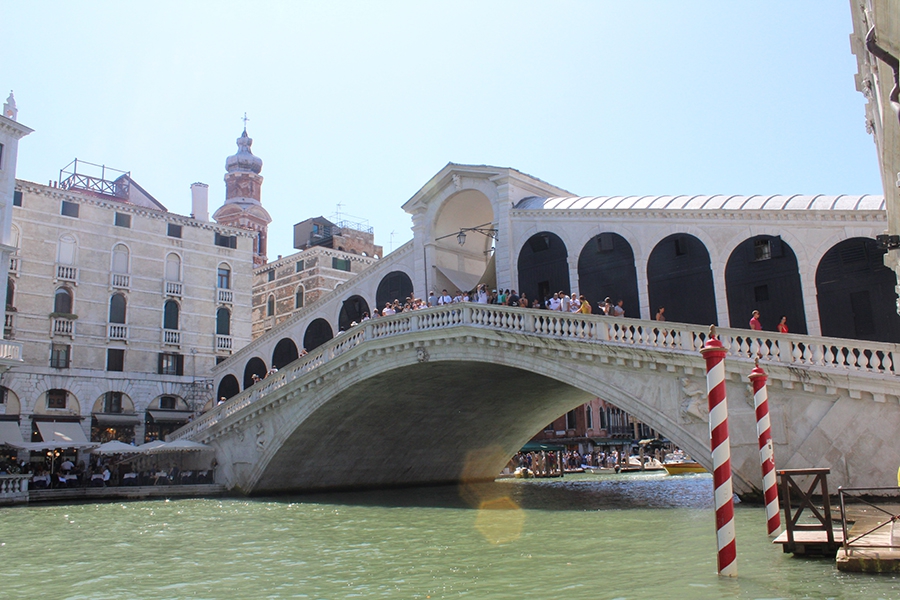
Time should also be set aside to visit the exquisite Chiesa Santa Maria di Miracoli in Cannaregio. Designed by Pietro Lombardo in 1481, this masterpiece of Renaissance architecture is simply one of the most perfect buildings in the world. Another majestic building - Palazzo Venier dei Leoni – residing beside the Grand Canal, now houses the Peggy Guggenheim Museum of Modern Art, including works by Chagall, Matisse, Klee, and Picasso.
Seldom in the wonderful world of cruising is reality so entertainingly edited; rarely do you witness a city of lost dreams marooned in the past. Little wonder Charles Dickens said of Venice: “I never saw the thing before that I should not be so afraid to describe”.
This city of abundant charms doesn't come cheap, with top hotels commanding rates that inhabit the stratosphere. But there is a keenly-priced option that showcases not just the city itself, but the tranquil islands of the Venetian Lagoon, where even richer history unfolds during a cruise unlike any other. What's more, because the incomparable SS La Venezia is a riverboat, the recent legislation prohibiting larger ships from sailing into the city doesn't apply. Having revelled in a recent seven-night 'Venice & the Jewels of Veneto' cruise, getting up-close and personal with this surreal destination, I'm convinced this is one of travel's best kept secrets.
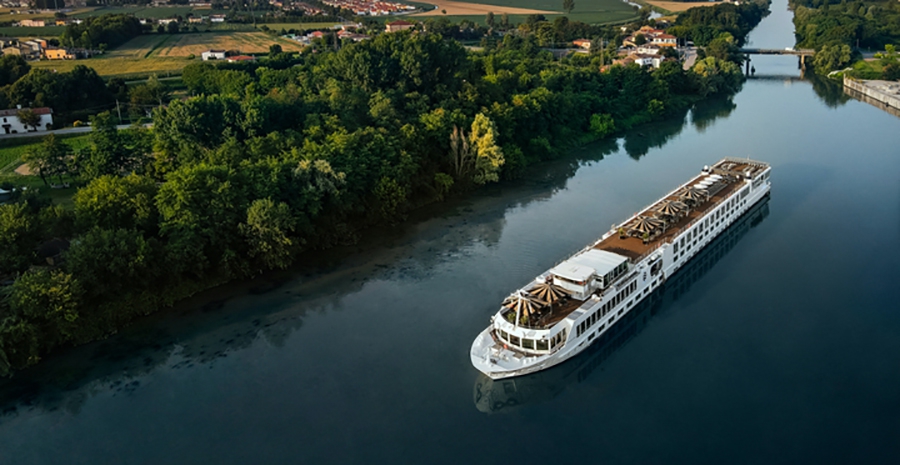
Renowned for their fleet of boutique river cruisers, Uniworld is in a league of its own. Each ‘Super Ship’ is unique, and every deck embodies an eclectic synthesis of flamboyant, refined élan. The 126-guest S.S. La Venezia is no exception.
From the riverboat’s berth at San Basilio (the embarkation point with vehicular access), I looked across the Canale della Giudecca to the factory established by Mariano Fortuny in 1922. This is where the company still produces the silken cotton printed with art nouveau patterns. It was these fabrics that inspired the interior designers of my floating fashionista.
Nowhere does this shimmering Fortuny fantasy hold more sway and swags than in the Grand Suites and Suites; as well as French Balcony; Deluxe and Classic Staterooms with windows. The comfy handcrafted Savoir beds come with high-thread count Egyptian cotton sheets and duvets. Even the marble bathrooms serve up luxuries, from heated towel racks, to Asprey amenities.
The focal hub that is Hari’s Bar and Lounge overflows with antique mirrors and Murano glass wall lamps. Ruffled Fortuny drapery sets off the furniture in shades of silver, cerulean and bronze. There’s a separate Panini Bar with a blue palette and crystal chandeliers.
In Ristorante Rialto, with its booth-style seating and button-back tan leather chairs, local specialities are offered at the lunch buffet as well as headlining the dinner menus. Complimentary red and white Italian wines are served at lunch and dinner.
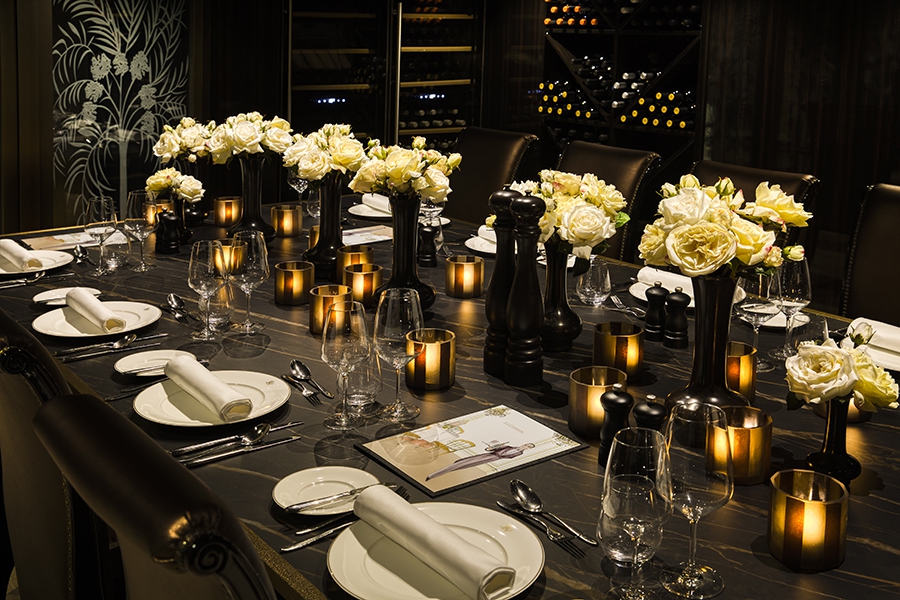
For a splurge, guests can dine in the intimate La Cantinetta, where a chef creates traditional Italian dishes, each paired with fine regional wines. A more casual alternative is Cielo’s, which serves wood-fired pizzas – with panoramic views.
Entertainment is low-key, but with drinks poured on a complimentary basis, the camaraderie in Hari’s Bar and Lounge is well fuelled. One night, ‘Maria’s live band’ got the crowd dancing, on another, ‘Musica in Maschera’ infused a more dignified ambiance to the after-dinner merriment.
A small gym squeezes in Life-Fitness equipment; a Serenity Spa offers therapies using Rituals products; there’s a guest laundry, a 24-hour tea and coffee station; as well as a lift between all three accommodation decks.
When not exploring the city itself, SS La Venezia navigates the outer reaches of the Venetian Lagoon, a 212-square-mile fragile ecosystem where ocean tides from the Adriatic meet freshwater streams from alpine rivers. From the pale pink of dawn to the deep orange of sunset, the lagoon is a single constant in Venice. As I travelled its waters from island to island, its rich history slowly unfolded.
Burano offers such photogenic prettiness, Instagram went into overdrive as I snapped brightly painted fishermen’s cottages in vibrant shades of vermilion, saffron, pink, purple, and sapphire.
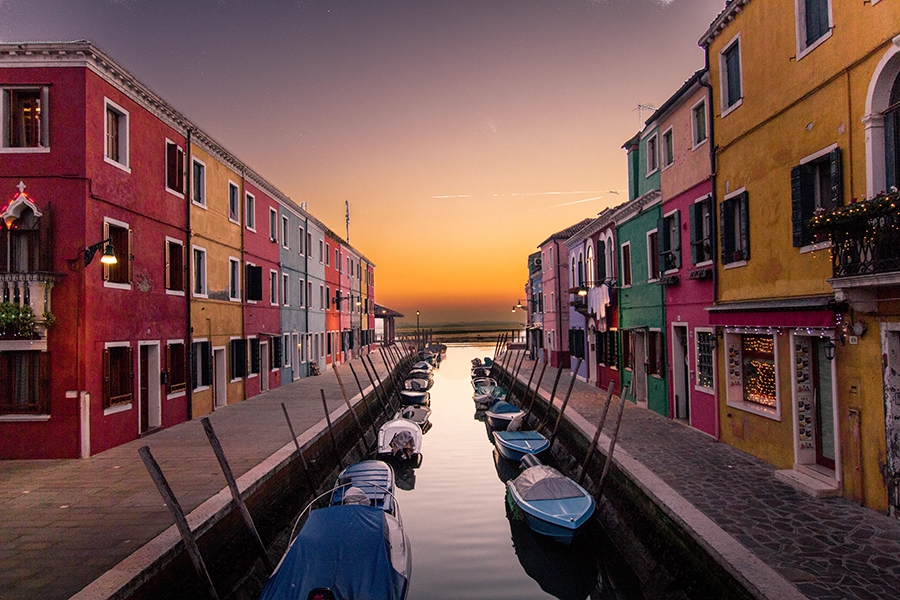
A haven nearly 500 years before Venice became an empire, Torcello, in the northern part of the lagoon, is surrounded by mud flats and marshes. The Basilica di Santa Maria Assunta, founded in 638, was rebuilt in the 11th century. Here the erudite art historian interpreted the mosaics, including a magnificent depiction of the Last Judgement with beguiling visions of angels, saints, and demons.
Reaching the island of Mazzorbo, I entered the walled vineyard of the Venissa Wine Estate. There’s only one hectare of Dorona di Venezia grapes left in the world, and only 3,500 bottles are produced annually, so I felt privileged to taste this rare wine.
Another day, heading south, the vessel hugged the sliver of land and sand that separates the Venetian Lagoon from the Adriatic, passing Pellestrina with its communities of fishermen living in tiny cottages painted in a kaleidoscope of bright colours, before arriving at Chioggia. I ambled through the Corso del Popolo, the wide main street in the heart of this historic town nicknamed ‘Little Venice.' At the ferry terminal, a traditional wooden bragozzo waited to take guests to see local mussel beds before heading to the southernmost section of the engineering marvel that is the MOSE flood barrier system.
The northbound journey through the lagoon offered yet more eye-candy. The rose-tinted sky kissed the glassy water where cormorants stretched their wings out to dry atop bricole, the wooden poles marking the navigable waterways. Ahead of us and glowing in the waning sunlight, Italy’s most compelling city appeared like a celestial frieze of belvederes and domes.
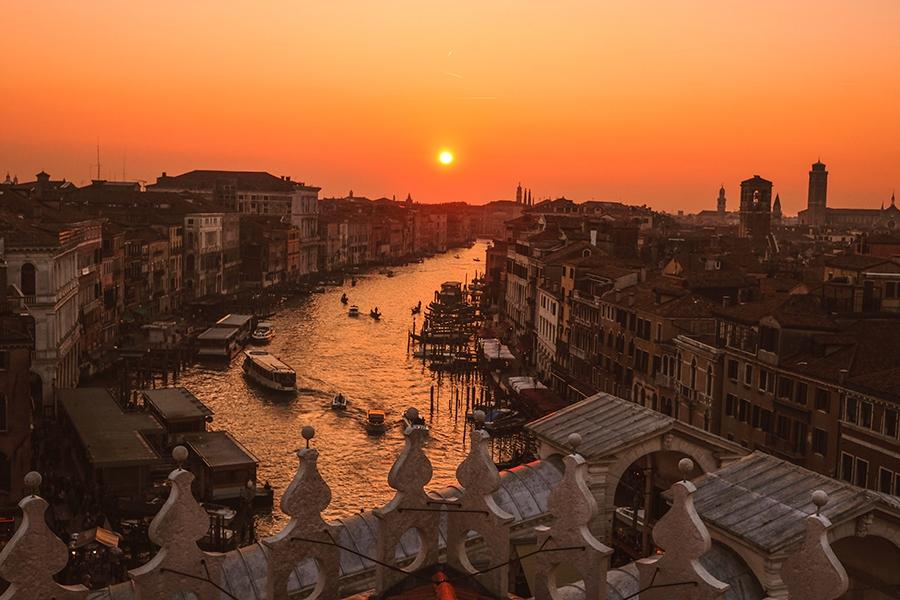
This cruise also offers an excursion to medieval Padua. Here I wandered through the largest public square in Europe, Prato della Valle, originally laid out by the Romans and transformed in the 18th century into a graceful, open space with a central elliptical island on whose banks stand a double ring of statues of local nobles. But the undeniable highlight was gazing at the wondrous frescoes by Giotto in the Cappella degli Scrovegni.
Without doubt, the ‘Uniworld Exclusive’ after-hours visit to the Basilica di San Marco was exceptional. A spine-tingling lighting ceremony brought the 43,000 sq ft of glittering gold-leaf and luminous mosaics to life. I also got a jewellers-eye view of the Pala d’Oro, an opulent gold and silver altarpiece believed to have been brought from Constantinople around 1105. This cruise through serendipity is to encounter beauty beyond words. I know how Dickens felt!
A huge thanks to Gary Buchanan for providing this piece.




